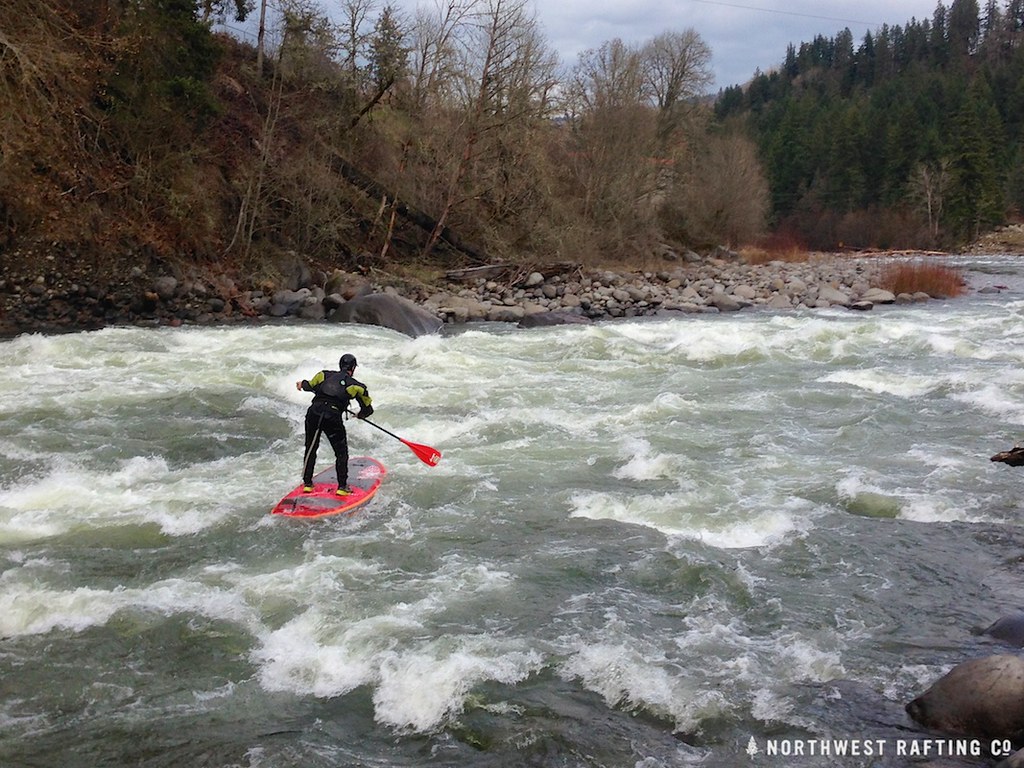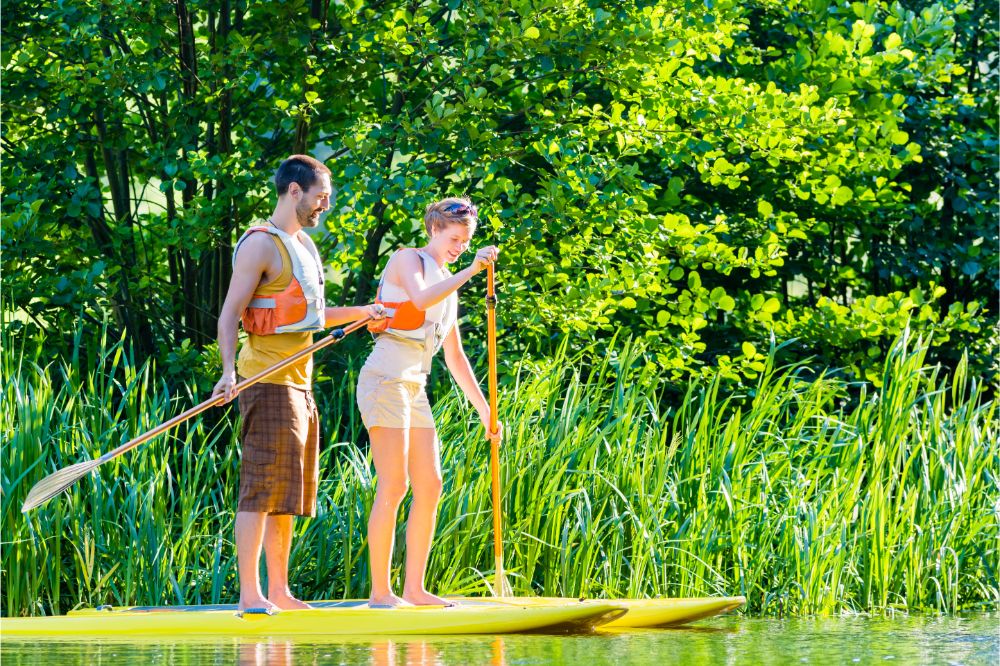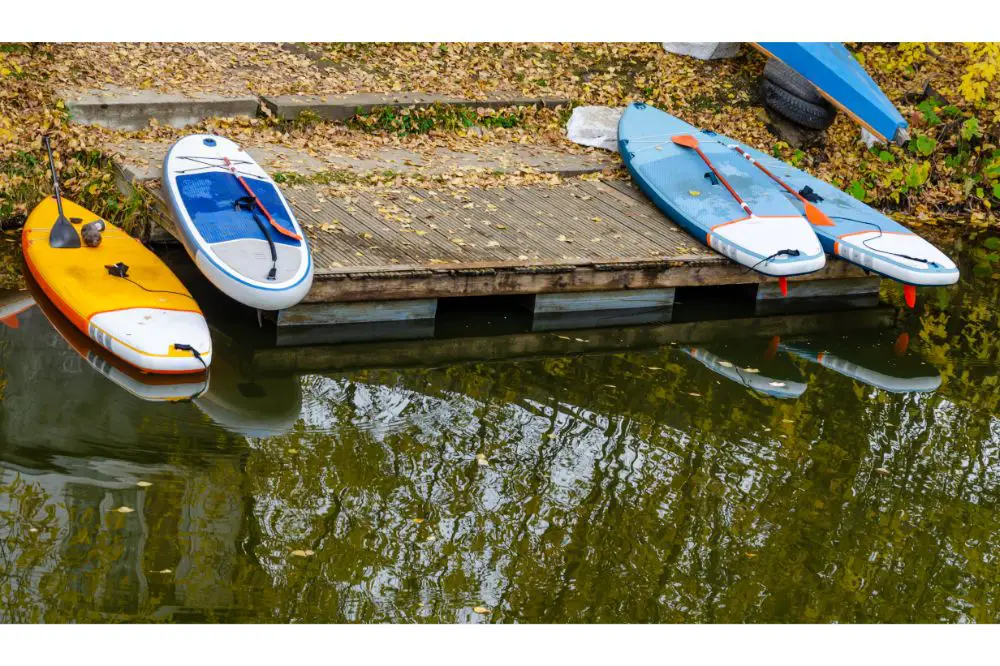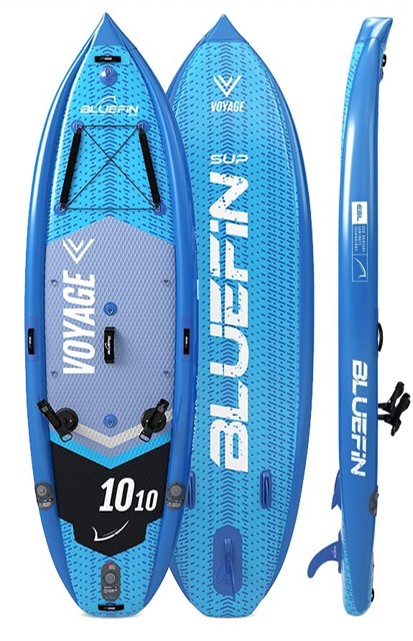Paddling in rivers offers different kinds of fun, adventure, and opportunities. Flowing river currents can be gentle or rapid. And rivers have flat waters too. Choosing a whitewater paddleboard will largely depend on the water terrain you’re planning to use it on.
Some boards may not last long if continually used in fast-flowing rivers with several obstacles. Other boards are designed specifically for that purpose. Here we will look at what you need to know about Whitewater SUP Boards.

What is a WhiteWater SUP Board?
White water or river SUP boards are specially designed to be used on rivers. They are rugged and maneuverable, and their profile is designed to give you the responsiveness you need to paddle the river and surf.
- Fins.
These are essential features of river SUPs as their design affects stability, speed, and how responsive the board is to maneuver.
Fins also allow a board to move in a straight line while on the water. The fins for river stand-up paddleboards are usually made of plastic to protect them from damage if they bump into a rock.
These boards have varying fin setups, including 2-fin, 3-fin, 4-fin, and 5-fin setups. These fins can be set up in various configurations, so it is crucial to have removable fins you can swap out. - Hull type.
The planing hull and the displacement hull are the two hull options. The former is flatter and wider and is an excellent choice for beginners. It also offers more stability. The displacement hull is great for going long distances and is an excellent choice for those who want a faster board. For whitewater SUP, we recommend using a planing hull. - Length.
The length of your board is an important feature of your river SUP board. The purpose you need your board for should determine the length of your board. For whitewater SUP, having a board that is easily maneuverable is essential in order to avoid obstacles. Shorter boards can easily get through rapids and are more maneuverable. - Width.
A wider board is a more stable board. Although narrower boards are faster, they require more experience. Hence, getting a paddleboard suitable to your skill level and purpose is important. For river running, a board of medium width will do just fine. River surfing requires a wider board for more stability.
To get the most out of your experience on whitewater, choosing the right board is vital. A board with a planing hull and a relatively short length is a great way to start. Ideally, your board will also have an adaptive fin box so you can adjust the fin setup to suit your needs.
The different activities on whitewater usually require using different boards. Below are the types of river stand-up paddleboards differentiated based on their use.
Types of river stand-up paddleboards
River SUPs can be divided into four categories based on their shapes: all-around boards for whitewater, river running boards, river surfing boards, and specialized white water boards.
- River surfing boards.
Surfing on a river’s waves makes fewer demands on a board than surfing on an ocean’s waves. Boards specifically used for river surfing have their nose and tail rounded or almost rectangular. They usually have a length of about 10 feet. Their rocker curve promotes prolonged planing while keeping the nose of the board out of the water. - River running boards.
Moving through rapids can be tricky, which is why stability is crucial. Manoeuvering around rocks and other obstacles in a river is easier done on shorter boards, so shorter, wider boards are excellent for river running. You want your board to be about 10 feet or less (see the Aqua Marina Rapid shown above). These boards often have many rockers that keep the board’s nose from being submerged in water. - All-around boards for whitewater.
Most times, a river has different paddling terrains, and having a river SUP board that sees you through all of them would be great. An all-around board you want to use on a river should be not much longer than 10 feet, 32″ to 34″ wide, and have a fin system you can configure to your taste. All-around boards for rivers usually have moderate rockers and can see you through difficult river conditions when well configured. - Specialized white water boards.
These boards are only for experts. They are short, very responsive and ultimatively optimized for the usage in rough whitewater.
Stand-up paddling on the river is good fun. However, it is quite important that you have all your accessories and stay safe.
Is an Inflatable Board Feasible for River Stand Up Paddling?
Inflatable SUP boards, also called iSUPs, are not only feasible for river SUP, but they are also excellent for the purpose. They are especially suited for river running because they graciously absorb contact with obstacles. Except for the fin, they can’t be scratched or dinged, and they are extremely difficult to pop.
Inflatable boards are lightweight and are easy to store and carry around. Those with multiple chambers have higher rails. The higher rails offer you more stability when you need to lean the board hard. Inflatable SUPs also have deck pads that will cushion a fall.
An inflatable SUP board is your best bet for leisure river surfing or moving through fast-flowing rapids. The boards are sturdy and durable. And if there is a problem, they are easy to repair.
Although you can also take river trips with hard boards, the iSUPs are clearly preferable here due to their sturdiness.
However, the wilder the river becomes, the more likely you are to encounter a stone or other obstacle. Nowadays, the iSUP variants are so strong and sturdy that this is usually no problem at all. They are also easy to repair.
What else to consider for River SUP?
And remember that besides the board it is also important that you must consider the to also choose the right SUP accessories for whitewater or river SUP.
Paddle
We recommend the cheaper Vario paddles with a soft plastic surface. The harder the paddle blade, the more likely it is to break when used in the river.
Safety
One of the most important things about river trips is safety. River paddling can be very dangerous!
In addition to currents and waves, it is important to keep in mind the risk of falling on unseen stones.
Mandatory equipment for whitewater SUP are therefore:
- Helmet
- Kayak vest
- Water shoes
- Knee pad
- Throwing bag and PFD (Personal Floating Device)
In addition, the coiled leash should only be mounted while in balancing water (lots of white water and deep riverbed) and only with a safety closure. Do not use the leash in blocked waters! Since all river boards are iSUP (inflatable SUP), so to speak, we also recommend purchasing a good pump.
Some of the best paddle options in the market are discussed here.

Who Should Use These Types of Boards?
When leisurely paddling in relatively gentle river terrain, you may decide to use an all around shaped river SUP board or even a pure all-around SUP board. But some whitewater activities and terrain require you to use boards designed to get through them.
Therefore: if you are advanced enough and plan to ride some rougher rapids, then you should definitely use a SUP board which is more specifically designed for whitewater SUP like the Aqua Marina Rapid 9’6”.
A Great Example of a River Stand Up Paddle Board
The Aqua Marina Rapid 9’6″ iSUP is well recognized for its versatility and sturdiness. The board is an all-around inflatable stand-up paddleboard, and it has an eye-catching design. It is quite rigid and an excellent option for smaller paddlers. The Aqua Marina Rapid weighs only 16.5 pounds and can support a weight of up to 198 pounds.
The board features multiple grab handles and it has a raised kicktail. This river SUP board is durable and designed to withstand abuse. It is also fun for surfing and has dual stringer technology.

What Else Should you Consider When Choosing a Board?
Apart from choosing a river SUP for your purposes, you should consider your skill level. Asking yourself how skilled you are is vital. As a beginner, there are some boards you have no business using. Your primary focus should be to learn, have fun, and explore. Beginners often go for wider boards because they offer more stability. Most experienced paddlers are focused more on speed and efficiency. Going for narrower boards is an excellent option, as they are generally faster.
You should also consider the right board size for you. Different boards support different weight ranges. When choosing a stand-up paddleboard, you will want to choose a board that can comfortably accommodate your weight. A heavier paddler than the board can accommodate will make the board sit lower in the water. This will result in more drag and you will have a slower paddleboard.
Other things you should consider when choosing a board can be found in our SUP Buying Guide.
Conclusion
River and Whitewater SUP is fun and offers a lot of adventure! Anyone who has ever made a nice tour on a river and possibly even mastered a few wilder passages will be thrilled.
But for Stand Up Paddling on the river you should consider a few points:
- You should ride a shorter and wider board than on flat water
- The board should have more rocker
- An inflatable board is preferable as they are much more robust than harboards
- Paddles and fins will suffer. Therefore, it is better to take a cheaper paddle with a plastic paddle blade than a high performance carbon paddle. Also, your board should have replaceable fins.
- Safety is always important, but it is extremely elementary when paddling on a river. Rivers are by definition more dangerous than stagnant waters like lakes or the ocean. A vest is therefore mandatory for everyone, regardless of age.
Therefore it is really important that an absolute beginner should first train their SUP Skills before going into a river. The most important SUP Techniques are explained in our Tips And Advice Section.
Finally we hope that we managed to have helped you with the information about river and whitewater SUP Boards! So grab a board, get out and have fun!


